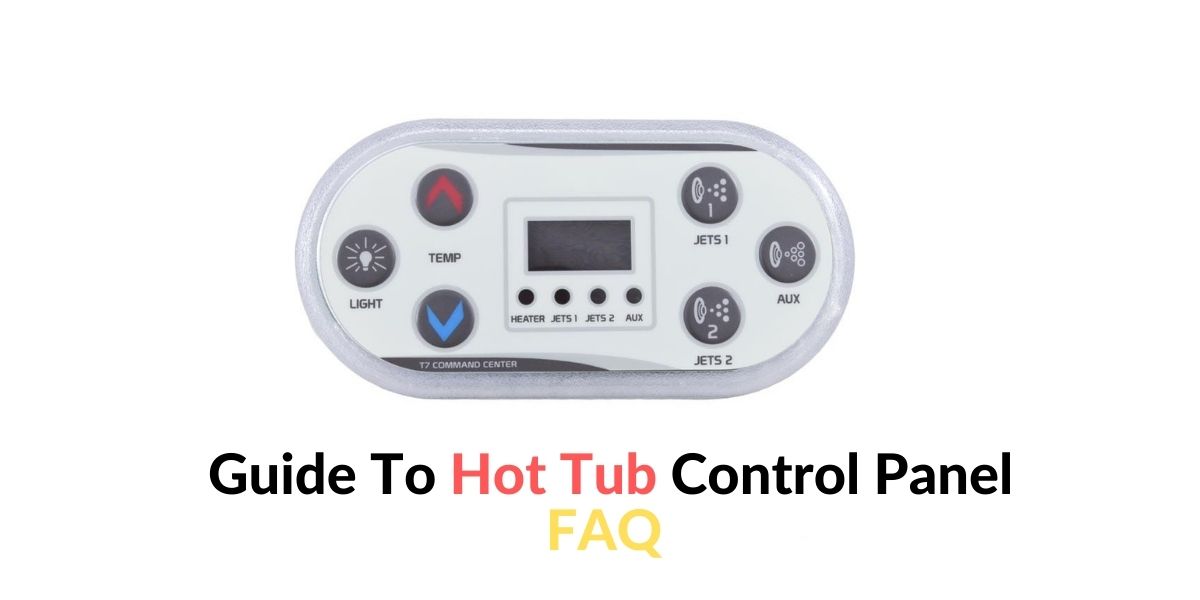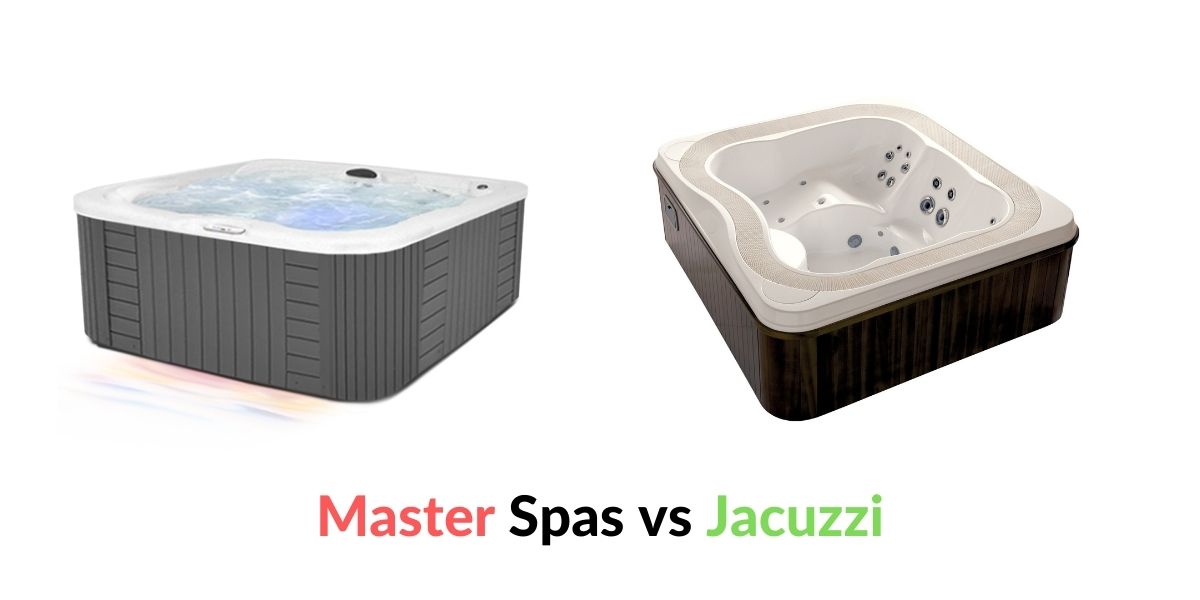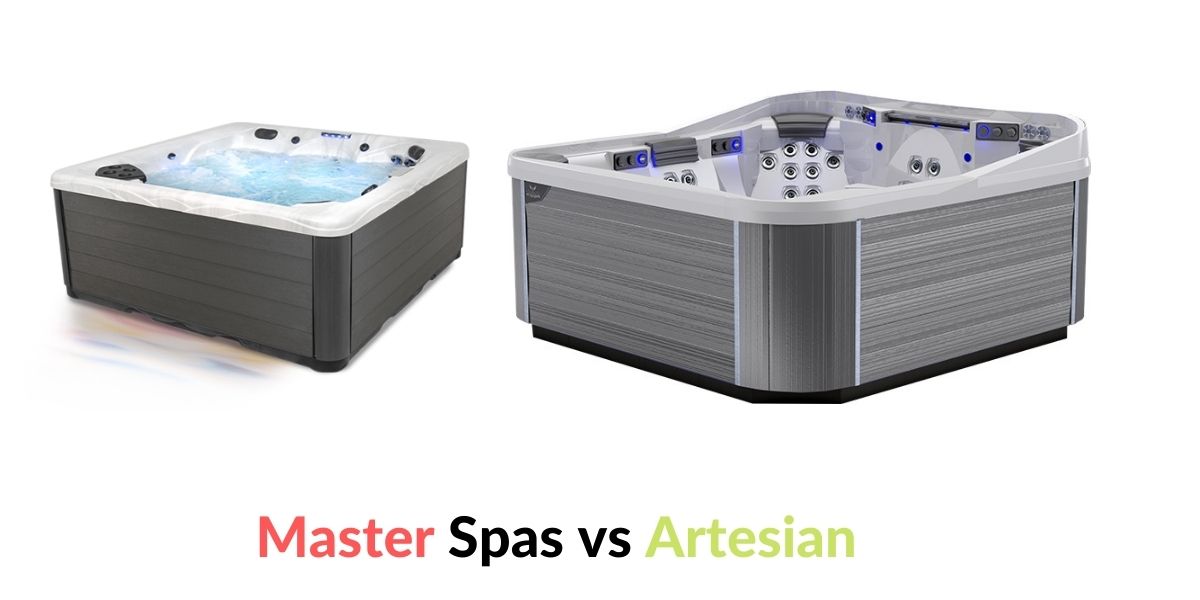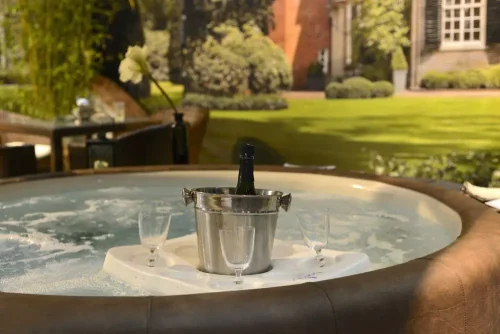All About Your Hot Tub Chemistry [2024]
The reason you have to use chemistry in your hot tub is simply because you will be reusing the water so it is important to keep the water clean and reuseable. Otherwise your water bill would be too much.
Most importantly, you need to balance the water to keep it from growing algae, health-threatening bacteria, and all sorts of other nasty organisms. To do that, you need hot tub specific chemicals. But which ones? And when do you add them? How much of each one do you need? And how do you add them to your hot tub?
It’s not as confusing as it may seem, once you get a handle on the what, when, and how of the spa chemicals, then you can make that dream a reality.
Do I Really Need to Use Hot Tub Chemicals?
Yes, you do! The same water stays in your hot tub for weeks, sometimes months. Without chemicals to keep it sanitized, it would quickly turn into an incubation chamber for nasty organisms you definitely would not want to soak in.
What Chemicals Do I Need to Start a Hot Tub?
Sanitizer
This is the most important of all the chemicals you’ll use because it’s what keeps your hot tub, well, sanitized.
The first thing to decide is which sanitizer you want to use, and you have a handful to choose from:
- Chlorine
- Bromine
- Biguanide
- Minerals
- Salt System
Each one has its pros and cons, so take the time to learn about them:
Chlorine
Being the most common sanitizer, chlorine has a few advantages over the others for it’s cost-effective, it’s easy to add and manage and it’s an aggressive bacteria and algae killer.
The same way you may consider using bleach to kill bacteria, fungus, and viruses in your bathroom, chlorine does all that for your hot tub water.
One drawback to chlorine can be the smell it gives off but it’s not the chlorine that smells. Chlorine kills contaminants by oxidizing, breaking down into its chemicals components. A chemical reaction occurs, as a result, the oxidation gives off waste products called chloramines. They’re what causes that chlorine smell.
If you can smell “chlorine”, it means you actually don’t have enough chlorine in your water because it’s been used up.
Test your water, and if the level is below, shock your hot tub to bring it back up quickly, get rid of the chloramines, and put the chlorine back to work killing contaminants.
- Effectively sanitizes and shocks hot water
- Compatible with chlorine sanitizing systems
- Keeps water clean and clear
- Used for spas and hot tubs
- Makes for a great spa experience
Proper Chlorine Level: 1 part per million (ppm) to 3 ppm
Bromine
This is probably the second-most common sanitizer, bromine has one distinctive advantage over chlorine – it doesn’t oxidize, which means it doesn’t give off chloramines. Instead, bromine ionizes contaminants, breaking them apart at the molecular level.
The process produces a different waste product – bromamines. While they don’t smell and aren’t as noxious as chloramines. Bromine still reduces the sanitizer’s effectiveness, and you don’t want them to hang around your hot tub. Keeping your bromine level steady will prevent this.
Bromine also has a few other advantages over chlorine for it has a lower pH than chlorine. That’s why it is gentler on your skin. It has a lower pH than chlorine, making it a little easier to keep the water balanced and it lasts longer.
Bromine does have a couple of drawbacks. While it lasts longer than chlorine, it also works more slowly, which means contaminants are in the water long before they’re destroyed.
It’s also unstabilized, which means if you use it in an uncovered, outdoor hot tub, it’ll burn off quickly under the sun because bromine doesn’t have a stabilizing partner chemical unlike chlorine, which can be stabilized by cyanuric acid. We think it’s best for indoor hot tubs or at least ones that are outside but not in direct sunlight.
- Spa Essentials Brominating Concentrate for Spas and Hot Tubs 2#
- Effective way to add bromine in granular form, acts both as a sanitizer and oxidizer to keep your spa clean and healthy
- Add directly to your spa water, no pre-dissolving needed
- One step treatment makes owning a spa easier than ever!
Proper Bromine Level: 3 ppm to 5 ppm
Biguanide
Biguanide is a non-chlorine sanitizer, biguanide kills bacteria just as well as chlorine and bromine do. It has a few other advantages as well for it doesn’t need to be used as frequently as chlorine or bromine. It’s odorless and it makes the water feel smoother to you and your hot tub guests.
On the downside, biguanide usually costs more than chlorine and bromine. It’s been known to cause deterioration in some spa parts like rubber gaskets and certain plastics. That’s why you should check with your hot tub manufacturer before using it.
Proper Biguanide Level: 30 ppm to 50 ppm
Minerals
Silver is a known bactericide, and copper is a known algaecide. A hot tub mineral sanitizer uses one or both of them as active ingredients. Its biggest pro is also a bit of a con.
If you use a mineral sanitizer it means you can use less chlorine. The water won’t be as harsh on your skin. But we said less chlorine, not no chlorine. Minerals alone are not enough to properly sanitize spa water, so you must supplement with chlorine to get the full sanitizing effect.
Minerals are less expensive but remember you’ll be using two spa chemicals for sanitation rather than just one, but because you use so little chlorine, you also won’t have a problem with chloramines or the smell they produce.
Minerals are very easy to manage because there’s no measuring out chemicals to add them to the water, and then waiting for them to disperse. Good thing, they come in an automatically dosing “stick,” which you simply add to your filter and replace every three to four months and be sure to follow the manufacturer’s instructions.
- For use in FROG Serene (formerly Spa FROG) Floating System or In-Line System with the Bromine Cartridge (sold separately); FROG Serene eliminates organic contaminants 2 ways with a low level of bromine and FROG Sanitizing Minerals
- The FROG Serene Fresh Mineral Water hot tub system uses Bromine and Mineral Cartridges that eliminates organic contaminants, reduce bromine use by up to 50%* and improve the overall quality of hot tub water
- Unlike chlorine, bromine slowly dissolves in hot water so it’s easier to regulate, has far less odors and is less impacted by pH swings making sanitizing more effective. Say goodbye to constant monitoring
- You use less bromine, making water easier on skin, hair, swimsuits, and your hot tub’s surfaces. FROG Sanitizing Minerals condition the water for softness and absorb acid to help keep pH balanced
- Each Mineral Cartridge lasts four months or whenever the hot tub is drained and refilled. It’s prefilled, eliminates the work and guesswork, and makes replacement quick and easy, plus it’s recyclable when empty
Proper Mineral Level: 0.5 ppm of chlorine or 1.0 ppm of bromine
Salt Systems
You may have heard of saltwater pools, right? Well, you could have a saltwater hot tub, too, if you consider one. All it takes is a device called a Salt Chlorine Generator.
Saltwater hot tubs still use chlorine as a sanitizer. The generator converts the salt into chlorine, so instead of buying chlorine, you buy salt, which is a lot less expensive. Salt Water hot tubs have no unpleasant odor. The water with salt will also be a lot softer and gentler on your eyes, hair, and skin.
To measure both salinity and chlorine, you may use test strips made for saltwater.
Proper Salt Level: 2,000 ppm to 3,000 ppm, with 2,500 being ideal
Proper Chlorine Level: 1 ppm to 3 ppm (just like a chlorine spa)
Shock Treatment
It is recommended that you shock your hot tub once a week or depending on bather load – more often if it’s seeing heavy use. And If your levels are all good, but the water is a bit cloudy or doesn’t quite smell right, it’s time for a shock.
You should also shock the tub if you haven’t used it for an extended period of time. What makes this one of the most important hot tub chemicals around is its ability to give your hot tub some super sanitizing when it needs it.
Chlorine Hot Tubs
You can use:
- Chlorine shock
- More chlorine
- Non-chlorine shock
Bromine Hot Tubs
You can use:
- Chlorine shock
- More bromine
- Non-chlorine shock
Mineral Hot Tubs
Mineral systems use so little chlorine. It is recommended that using a non-chlorine shock to keep the chlorine levels low.
Biguanide Hot Tubs
If you are using biguanide as your sanitizer, be informed that those chemical systems have their own shock designed specifically for the brand you use.
No matter what sanitizer you are currently using, your hot tub water’s alkalinity and pH will need to be balanced for the sanitizer to do its job.
Alkalinity
In balancing your hot tub chemistry, you’ll need to adjust alkalinity before trying to balance the pH level. Alkalinity acts as a pH buffer, keeping it from drastically changing.
Yes, Use Soda To Raise Hot Tub Alkalinity [1 tbs/100 gallons]
It can be a delicate operation to get alkalinity levels just right. If your water’s alkalinity gets too low – less than 125 ppm – it can also bring the pH level down, and the water will become acidic.
For this reason, you need to keep an alkalinity increaser in your spa chemical storage cabinet.
But what if the alkalinity gets too high? Well, there’s actually no such spa chemical as an alkalinity decreaser. To lower it, you may use a pH decreaser which will lower both. This dependency and interaction is part of the difficulty in getting these two levels right.
Proper Level For Alkalinity: 125 ppm to 150 ppm
pH
Once you have the alkalinity stable, turn your attention to the hot tub pH level.
Too much pH is one of the main causes of cloudy hot tub water. If the level goes above 7.6, and you start to see problems, try to use a pH decreaser to brings things back down to normal.
- Optimal Water Balance: Achieve the perfect pH and alkalinity levels effortlessly. Maintain ideal chemical balance for a soothing, clean spa experience. This potent formula ensures your water chemistry stays within recommended ranges for enhanced relaxation and performance.
- Comprehensive Compatibility: Works seamlessly with various purification systems like chlorine, bromine, and mineral purifiers. Suitable for freshwater pools of different sizes, catering to pools up to 2000 gallons and ensuring consistent, balanced water quality.
- Effortless Application: Simplify maintenance routines. Easily administer the product directly into your hot tub or pool. Just add it as needed during your routine pH and alkalinity checks. Keep your water in optimal condition without hassle or complexity.
- Professional Instructions for Use: Clear, step-by-step guidance ensures you get it right every time. Detailed usage instructions provided to efficiently raise pH levels and alkalinity. Test, add, circulate, and retest—achieving perfect balance is straightforward.
- Trusted Expertise: Hot Tub Things brings over 30 years of industry expertise. We're dedicated to delivering top-notch spa parts, exceptional service, and unbeatable prices. Trust in our commitment to quality for your ultimate spa experience.
If it’s too low, set in the pH increaser, and remember that it will also raise the alkalinity, and you’ll have to test and possibly adjust that level again.
If both the pH and alkalinity levels are low, just adding alkalinity increaser will raise both, but consider to adjust the pH if the alkalinity doesn’t bring it up to the correct level.
If both the pH and alkalinity levels are too high, use pH decreaser to drop them back.
- Lowers pH and alkalinity in spa and hot tub water
- Helps keep your spa water pH balanced between 7.2-7.8
- Prevents scaling and cloudy water caused by high pH
- Made in the USA
- Convenient quick dissolving granules
While you’re adjusting alkalinity and pH, you may need to test the water plenty of times to get everything right, so keep a supply of test strips on hand.
Important: Low pH and alkalinity can damage your hot tub because of the acidity of the water. High pH and alkalinity can cause scaling, which could lead to damaging the equipment.
The heater is at risk both ways. Acid due to low pH will eat away at the heater element, and high pH will deposit scale around the element, making it work harder to heat your hot tub that’s why checking the water several times is important.
Proper Level For pH: 7.4 to 7.6
Calcium Hardness in Water Balance
This is a measure of how hard the water in your hot tub is. Calcium hardness must be actively managed along with pH and total alkalinity to keep the hot tub water in proper chemical balance.
You want the calcium hardness in your hot tub to be a little on the higher side because if it’s too soft, it can eat away at your hot tub shell, pipes, and other parts, slowly breaking them down over time. Its function is to basically wreak all kinds of havoc in the water.
If the calcium hardness level somehow gets too high, that can make it difficult for the other hot tub chemicals you’re using to dissolve properly in the water, so it’s definitely a problem. It can lead to cloudy water and scaling on your hot tub and its components, just like what happens to your shower head.
The best solution is to drain your hot tub, scrub it, and start over with fresh water.
In order to keep the calcium hardness steady and your hot tub healthy, keep a bottle of calcium hardness increaser with the rest of your hot tub supplies.
Proper Calcium Hardness Level: 175 ppm to 250 ppm
Hot Tub Enzymes
Using a hot tub enzyme treatment like Natural Enzymes or EZ Enzyme will break down the organic waste that can then be filtered like skin cells, body oils, leaves, twigs, insects, all kinds of other nasties. Left too long, contaminants can clog filters and shorten their life cycle and those contaminants will break down, and you’ll have to deal with a wicked case of hot tub scum.
Using hot tub enzymes is not really necessary as long as you keep your sanitizer level balanced, and you drain, clean, and refill your hot tub on a regular basis, which is at least quarterly.
Water Clarifier
Water clarifiers work instantly, and you should notice clear water in just 72 hours. Now that your filter can remove these particles, your water will look clearer but because it’s not a maintenance item—it’s a temporary measure.
Water clarifier treats the symptom, not the cause of cloudy water, so it’ll clear things up for a little while. But if you don’t address the actual problem, it’ll go right back to the way it was once the clarifier diminishes.
So why considering it? Well, say you’re planning a hot tub get-together and the water’s looking less than inviting. Instead of spending a lot of time on testing and balancing, you can just pour in some clarifier, and then deal with the root issue later.
Always remember, it’s always preferable to keep your water clear and balanced. Water clarifier is a last and temporary resort.
How Do I Add All These Chemicals To My Hot Tub?
You just need to follow a few simple steps:
Keep Your Hot Tub Running
You want the spa chemicals to mix into the water. The hot tub jets will do this for you.
Do Not Cover Your Hot Tub
This is really a good idea to keep the chemicals from evaporating. That’s true on an everyday basis. Consider that right after you add chemicals, they need to off-gas, which means the chemicals break down, and a portion of them is released into the air.
Do you know that new-car smell? Yeah, that’s actually all the new fabric and plastics off-gassing, so it’s not good to enjoy it too much.
Off-gassing is normal, and you want those chemical gases to dissipate, so don’t trap them under your hot tub cover.
If your hot tub is located outside, the gases will just dissipate into the air. But if your hot tub is indoors, it’s a good thing to open a window or turn on a ventilation fan, or both, so those gases don’t go around the room where you’ll have to breathe them in.
Turn Off the Air Valves
Too much air in the water, and too much of the chemicals will off-gas and you don’t want this to happen too quickly. But you need some of the chemicals to remain in the water to do their jobs. So if your hot tub has air valves that increase jet pressure you should turn them off.
Test the Water
Before you add any hot tub chemicals, you need to know what the water needs and how much. To get this information, test the water using test strips or a liquid test kit.
- AFFORDABLE 7-IN-1 POOL TESTING KIT: Our 100 pool test strips provides an affordable, all in one pool water testing kit for various chemicals including Free Chlorine, Alkalinity, pH levels and more!
- QUICK & EASY: Simplify your pool and spa testing with our easy pool testing strips. Just dip our hot tub test strips into the water for 2 seconds, wait for 30 seconds, and compare the results accurately to the provided color chart.
- ACCURATE & RELIABLE: Our swimming pool test strips deliver highly precise readings, ensuring the safety and cleanliness of your pool or hot tub water. Utilize our pool strips at least twice a week for optimal maintenance.
- FREE E-BOOK: Gain access to valuable insights and tips on using our pool and spa test strips and maintaining balanced chemical levels with our complimentary eBook, enhancing your pool testing experience.
- TIPS FOR USAGE: Ensure the longevity and effectiveness of your pool test strips by keeping them away from moisture and light, securely closing the container after use, and using them within 90 days of opening.
The three main levels to be concerned about are alkalinity, pH, and sanitizer. If your alkalinity and pH are ineffective, the sanitizer can’t do its job.
Follow the Instructions
Refer to the manufacturer’s instructions on every chemical’s packaging to know how much of the chemical you need to either raise or lower the specific factor it’s going to address.
Measure Twice, Pour Once
Once you’ve determined which spa chemicals you need to add and how much to apply. You don’t want to just pour chemicals into your water straight from the container. The goal here is balanced water, not a chemical crapshoot.
Add The Hot Tub Chemicals
Lastly, just pour the measured chemicals straight into the hot tub water, and walk away. The jets will mix everything up. Leave your hot tub for at least 15 minutes, then you can cover it to prevent evaporation.
Before getting into the hot tub, test the water again to make sure the levels are where they need to be and If they’re not, repeat this process until they are.
Only You Can Prevent a Dirty Hot Tub
Aside from keeping your water balanced and having the right spa chemicals on hand to clear your water, you can do a few other things to keep your hot tub clean.
Keep Your Hot Tub Clean
We all get lazy from time to time, or we procrastinate. But this is one area where slacking can get you into more trouble in your spa water.
Use a good hot tub cleaner on a regular basis to keep things sanitary, and your water clear.
Shower Before Every Soak
This should be common sense, but an alarming number of people will just jump right into a hot tub without a shower because they figure the sanitizer will just take care of everything.
Sure, that’s what sanitizer is made for but it only does so much. Put too much burden on it, and it becomes less effective. Do your part by helping your sanitizer out by showering before you soak. This is even more important when you’re a guest in someone else’s hot tub or when someone is a guest in yours.
Keep Your Filter Clean
The filtration system in your hot tub has a great job. It’s there to remove everything from small bits of debris to bacteria from the water to keep you safe and healthy.
But if you’re not cleaning it on a regular basis, you’re making it more difficult for the filter to do its job. It can’t easily grab all the debris and gunk if it’s already full of debris and gunk. You must do your filter, your hot tub, and yourself a favor by cleaning it regularly.
Change Your Filter When Necessary
Even if you clean it on a regular basis, your hot tub filter will still need to be replaced eventually. Keep an eye on its condition when you remove it for cleanings and try to replace it when cleaning just isn’t enough to get it.
Keep Your Hot Tub Covered
Whether your spa is outside and exposed to leaves and bugs, or inside and exposed to dust using a hot tub cover will help keep things out that can dirty your water.
This also means less work and fewer chemicals, which results in less money spent on maintaining your hot tub. If you don’t have a cover, you should get one!
Drain and Clean Your Spa on a Regular Basis
It’s great if you’re already cleaning your hot tub regularly. Remember the least quarterly, drain and clean your hot tub. This is also the perfect time to use a line flush product to get rid of any biofilm that may be loitering in your plumbing. Give it a good scrubbing, refill it with clean, freshwater, and enjoy your spa again!
Dichlor / Bleach Method
Here is a quick guide to using the well known Dichlor/Bleach method. (i.e. Chlorine)
Initial Startup Procedure
- You want to balance water by lowering TA to about 80 ppm. You can use this article to read more about TA.
- Ventilate until pH is consistently 7.4 to 7.8. Lower your TA if pH rises above 7.8. On the other hand, raise your TA if pH stays below 7.4.
- Test your Calcium, and make note of it. It should stay within 100-150 ppm.
- Add 50 ppm Borates
- Shock your hot tub to 10 ppm FC using Dichlor the first night after filling.
- Then you should wait for 24 hours and test FC again in order to calculate Chlorine Demand.
- You can now start using your hot tub
- You can continue to use Dichlor after soaks (maintaining approx 7 ppm FC per person per hour) (or 3.5 tsp)
- Once you have added abut 34 ppm FC (approximately 30 ppm CYA) using Dichlor, switch to Clorox 6% unscented bleach. This takes about a week or so.
Ongoing Maintenance
After the initial startup procedure above, you’ll basically do the following:
- You want to check your FC every day or two (and before soaks).
- Then check CD as needed (once a week to start).
- Add plenty of Chlorine after soaks (on per as-needed basis) so FC always stays above zero, while CD stays low.
- Add MPS before/during high bather loads to help out the Chlorine, and keep CD low. (Optional but recommended)
- Keep checking your pH once a week, and adjust TA as needed.
- Maintain your filter every week or two, depending on use.
- Keep checking your CYA every 3 months, and raise by using Dichor if needed. It will take a few months before CYA is low.
- In case you experience foaming or cloudy water you can address this article to see how to fix it.
Water Change
- You want to change your water in 6 months and basically start over
- If this is a brand new hot tub, you want to change your water after the first month is up and then continue replacing your water bi-yearly.
- One to two times every year, try to use something like Spa Flush to clean out pipes before you drain 1 to 2 times.
- You will want to clean your filter with TSP every time you change your water.
- Decontamination should only be considered if your FC drops to zero for a prolonged time
You Passed the First Phase of Hot Tub Chemistry!
Keeping your water clear isn’t always about using hot tub chemicals. A big part of it is simply taking good care of what you have invested.
We all know that Hot tubs are not cheap. The better you maintain it, the longer it will last, and the more you’ll be able to enjoy it.
Happy Soaking



































